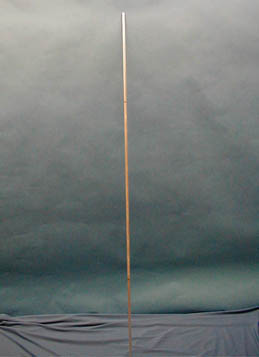Demos: 1S-42 Standing Waves (Metal Bar)


A long thin aluminum rod is used to show both transverse and longitudinal waves, the latter by producing a loud tone when rubbed.
Directions: First, hold the bar vertically by placing the fingers 1/4 distance from its end. Strike the bar sharply in the center with the side of the hand. Immediately swing it up and catch it in such a way that the bar is supported on the index fingers as shown. If done properly, the bar will show considerable transverse mechanical vibration since the fingers are at the nodes. (These are marked clearly on the rod so that you can see where to “catch” it.)
To demonstrate the longitudinal vibrations (which are much to small to be seen), hold the bar firmly at its center between your thumb and index finger and stroke it with the thumb and index finger of your other hand in a kind of pinching motion as you draw your hand down the bar. YOUR STROKING FINGERS SHOULD BE COATED WITH ROSIN to initiate the “stick-slip” motion required. When done properly, an ear-splitting sound will emanate from the rod. (Consult with the lec-demo technician for the proper technique, or, if you can’t quite get it, he will gladly do the demo for you in class.)
Suggestions for Presentation: It is best to practice the technique ahead of time. Be sure to hold the bar at the 1/4 L point so the vibrations won’t be damped out. For the sound part, you might want to have a pre-demo discussion about resonance, since the “stick-and-slip” action generates a wide variety of sounds, but most are suppressed except that which is at the resonance of the rod. (And you can get other resonances by holding the rod at other nodal points.)
Applications: Resonant frequencies in musical instruments.
Last Updated: Nov 30, 2023 11:25 AM